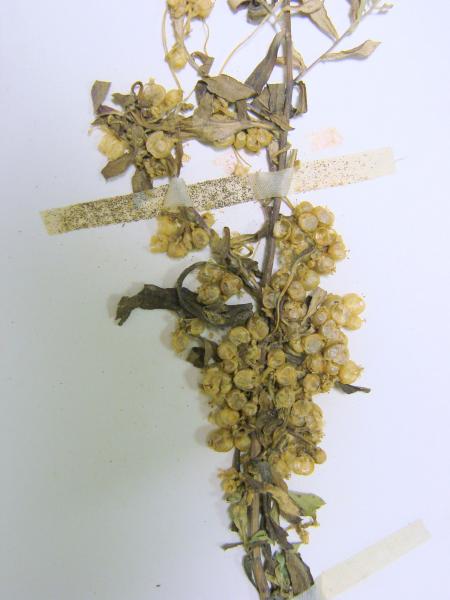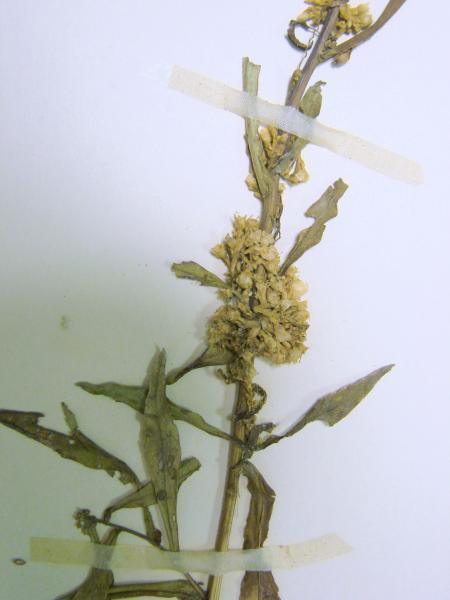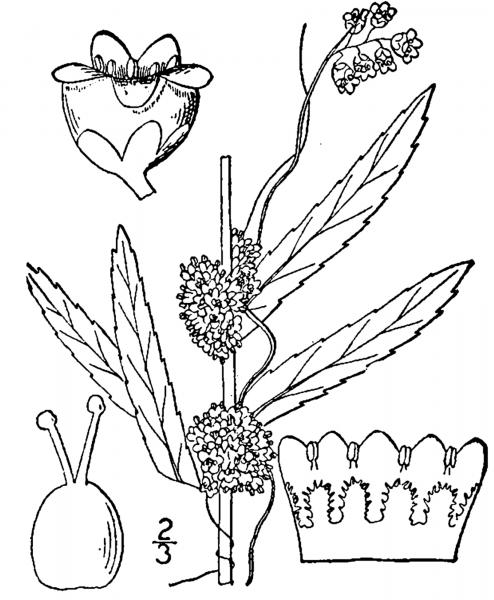Buttonbush Dodder
Cuscuta cephalanthi Engelm.
- Class
- Dicotyledoneae (Dicots)
- Family
- Convolvulaceae (Morning-Glory Family)
- State Protection
- Endangered
Listed as Endangered by New York State: in imminent danger of extirpation in New York. For animals, taking, importation, transportation, or possession is prohibited, except under license or permit. For plants, removal or damage without the consent of the landowner is prohibited.
- Federal Protection
- Not Listed
- State Conservation Status Rank
- S1
Critically Imperiled in New York - Especially vulnerable to disappearing from New York due to extreme rarity or other factors; typically 5 or fewer populations or locations in New York, very few individuals, very restricted range, very few remaining acres (or miles of stream), and/or very steep declines.
- Global Conservation Status Rank
- G5
Secure globally - Common in the world; widespread and abundant (but may be rare in some parts of its range).
Summary
Did you know?
Even though this dodder can be found on a variety of host plants, its species name refers to only one of them, the buttonbush (Cephalanthus). The common name may come from a Middle Dutch word meaning the yoke of an egg referring to the yellow color of some of the flowers of Cuscuta. Dodder is an annual but some of its connections to the host plant (haustoria) may survive the winter and start new plants already on the host in the spring. The vines always seem to wrap around the host plant in a counterclockwise direction. Dodder is a speed demon when it comes to finding a host. Germination, emergence and attachment to the host may occur in as little as 24 hours and the seedling must find a host in 5-10 days or it will die.
State Ranking Justification
There are four existing populations but little information is known about three of them. There are eight historical localities which have not been relocated.
Short-term Trends
None of the existing populations have been resurveyed since their discovery so short term trends are unknown.
Long-term Trends
The long-term trend seems to be down as none of the eight historical records have been relocated. However four new populations have been found since the 1980s. The real trend is probably unknown because these plants are difficult to survey and their habitat preference is relatively unknown. More directed survey work is needed and existing populations need to be resurveyed.
Conservation and Management
Threats
Whatever threatens the host plant of this species is also a threat. Unfortunately little is known about this.
Conservation Strategies and Management Practices
A natural buffer needs to be maintained around the wetlands where this species occurs to preserve the hydrologic régime and prevent habitat destruction.
Research Needs
More research is needed to determine the habitat and host plant preference in New York as it has been seen growing on asters and goldenrods as well as buttonbush. How this plant seed banks and moves around within its environment is unknown.
Habitat
Habitat
In New York the known sites for this species have all been wetlands of various types, from shrub swamps to streamsides, wet meadows, and marshes. Known host plants in the state include willows, asters, golderods, button-bush, horsetails, mints, and water-willow, so it appears to not be very particular (New York Natural Heritage Program 2007). Low grounds, on various shrubs and coarse herbs (Fernald 1970).
Associated Ecological Communities
- Deep emergent marsh*
(guide)
A marsh community flooded by waters that are not subject to violent wave action. Water depths can range from 6 in to 6.6 ft (15 cm to 2 m). Water levels may fluctuate seasonally, but the substrate is rarely dry, and there is usually standing water in the fall.
- Highbush blueberry bog thicket*
(guide)
A wetland usually fed by rainwater or mineral-poor groundwater and dominated by tall shrubs and peat mosses. The most abundant shrub is usually highbush blueberry. The water in the bog is usually nutrient-poor and acidic.
- Pine barrens shrub swamp*
(guide)
A shrub-dominated wetland that occurs in shallow depressions in the coastal plain, often as the transition zone between a coastal plain pond shore and either pitch pine-scrub oak barrens or pitch pine-oak forest.
- Shrub swamp
(guide)
An inland wetland dominated by tall shrubs that occurs along the shore of a lake or river, in a wet depression or valley not associated with lakes, or as a transition zone between a marsh, fen, or bog and a swamp or upland community. Shrub swamps are very common and quite variable.
* probable association but not confirmed.
Associated Species
- Cephalanthus occidentalis (buttonbush)
- Decodon
- Equisetum hyemale
- Mentha x piperita
- Salix
- Solidago
- Symphyotrichum lanceolatum
- Wolffia brasiliensis (Brazilian water-meal)
Range
New York State Distribution
This species known from scattered locations in eastern New York, and from Cayuga and Seneca Counties to the west.
Global Distribution
This tiny species is known from most of the United States, as well as some Canadian Provinces.
Identification Comments
General Description
Dodders are parasitic, annual plants, the seedlings attaching to a host plant soon after they sprout. The mature plants lack chlorophyll, roots, or leaves. They consist only of the pale yellor or orangish stems, attached to the host plant via numerous haustoria (suckers), and the compact (2-2.5mm) flowers. With prolific individuals the overall appearance is of a tangled mass of bumpy orange string sprawled and twining over the host plant. Upon closer inspection, the flowers are seen to be white, mostly 4-parted, sessile, and compact. The sepals are united at the base, and shorter than the corolla tube, the lobes of the corolla obtuse or rounded, also shorter than the tube, and the mature styles are 1 to 1.5mm long (slightly shorter than the fruit).
Best Life Stage for Proper Identification
Flowers are needed to distinguish among Cuscuta species.
Similar Species
Cuscuta polygonorum and C. coryli also have united sepals and 4-parted flowers, and occur in New York, but these species have acute rather than rounded corolla lobes, with a calyx equalling or surpassing the corolla lobe, rather than shorter.
Best Time to See
Flowers August to mid-October, fruits persist until the end of October.
- Flowering
- Fruiting
The time of year you would expect to find Buttonbush Dodder flowering and fruiting in New York.
Buttonbush Dodder Images
Taxonomy
Buttonbush Dodder
Cuscuta cephalanthi Engelm.
- Kingdom Plantae
- Phylum Anthophyta
- Class Dicotyledoneae
(Dicots)
- Order Solanales
- Family Convolvulaceae (Morning-Glory Family)
- Order Solanales
- Class Dicotyledoneae
(Dicots)
- Phylum Anthophyta
Additional Common Names
- Dodder
Additional Resources
Best Identification Reference
Gleason, Henry A. and A. Cronquist. 1991. Manual of Vascular Plants of Northeastern United States and Adjacent Canada. The New York Botanical Garden, Bronx, New York. 910 pp.
Other References
Fernald, M.L. 1950. Gray's manual of botany. 8th edition. D. Van Nostrand, New York. 1632 pp.
Haines, Arthur and Thomas F. Vining. 1998. Flora of Maine. A Manual for Identification of Native and Naturalized Vascular Plants of Maine.
Holmgren, Noel. 1998. The Illustrated Companion to Gleason and Cronquist's Manual. Illustrations of the Vascular Plants of Northeastern United States and Adjacent Canada. The New York Botanical Garden, Bronx, New York.
New York Natural Heritage Program. 2010. Biotics database. New York Natural Heritage Program. New York State Department of Environmental Conservation. Albany, NY.
New York Natural Heritage Program. 2024. New York Natural Heritage Program Databases. Albany, NY.
Reschke, Carol. 1990. Ecological communities of New York State. New York Natural Heritage Program, New York State Department of Environmental Conservation. Latham, NY. 96 pp. plus xi.
Rhoads, Ann F. and Timothy A. Block. 2000. The Plants of Pennsylvania, an Illustrated Manual. University of Pennsylvania Press, Philadelphia, PA.
Voss, Edward G. 1996. Michigan Flora Part III. Dicots Concluded (Pyrolaceae - Compositae). Cranbrook Institute of Science Bulletin 61 and University of Michigan Herbarium. 622 pp.
Weldy, T. and D. Werier. 2010. New York flora atlas. [S.M. Landry, K.N. Campbell, and L.D. Mabe (original application development), Florida Center for Community Design and Research http://www.fccdr.usf.edu/. University of South Florida http://www.usf.edu/]. New York Flora Association http://newyork.plantatlas.usf.edu/, Albany, New York
Weldy, Troy W. and David Werier. 2005. New York Flora Atlas. [S.M. Landry, K.N. Campbell, and L.D. Mabe (original application development), Florida Center for Community Design and Research. University of South Florida]. New York Flora Association, Albany, NY. Available on the web at (http://newyork.plantatlas.usf.edu/).
Yuncker, T.G. 1965. Cuscuta. In W.R. Buck, [ed.], North American Flora, series II, vol 4, 1-51. New York Botanical Garden Press, Bronx, New York.
Yuncker, Truman G. 1932. The Genus Cuscuta. Memoirs of the Torrey Botanical Club. Vol. 18(2). 113-331.
Links
About This Guide
Information for this guide was last updated on: January 18, 2008
Please cite this page as:
New York Natural Heritage Program. 2024.
Online Conservation Guide for
Cuscuta cephalanthi.
Available from: https://guides.nynhp.org/buttonbush-dodder/.
Accessed July 27, 2024.


